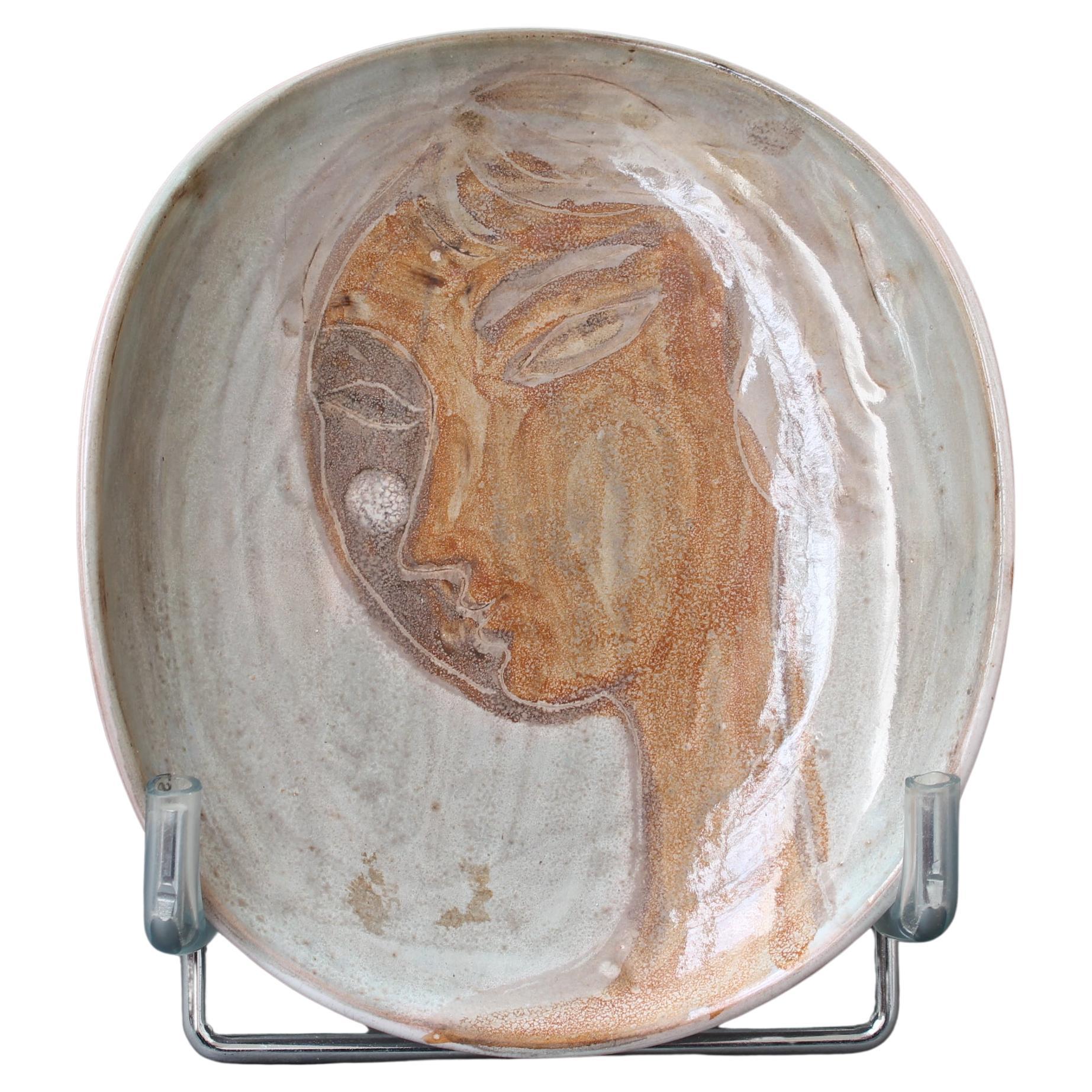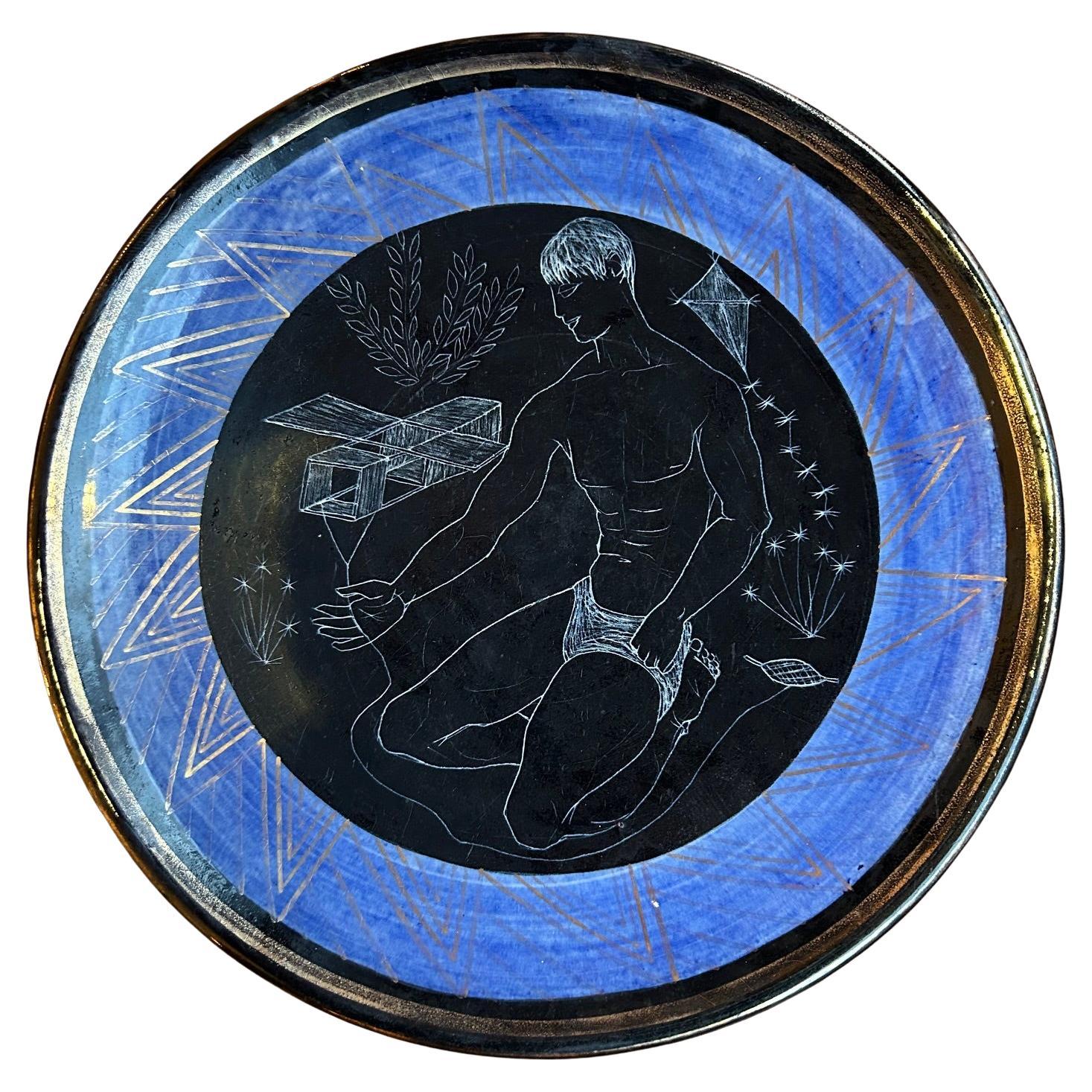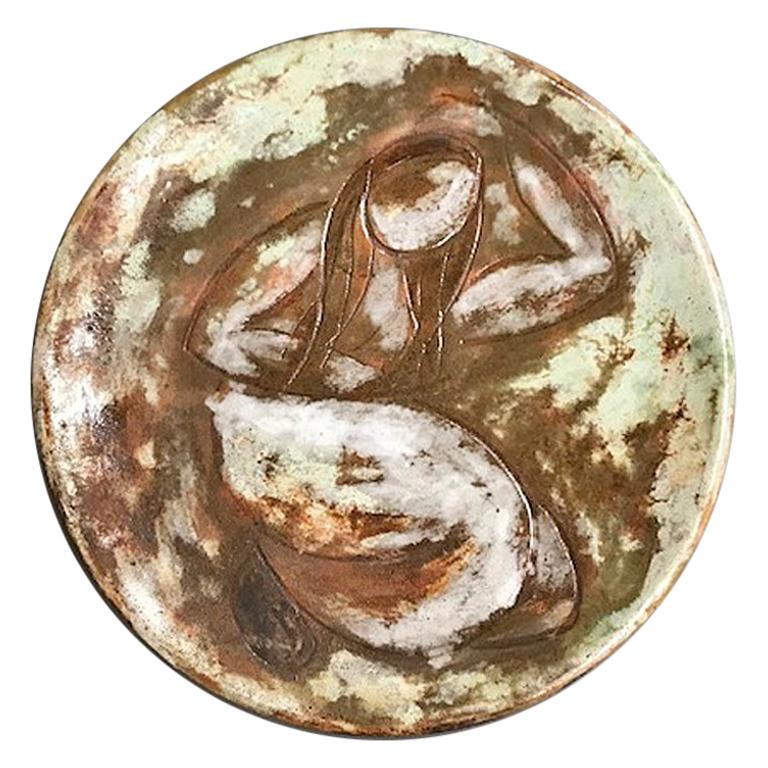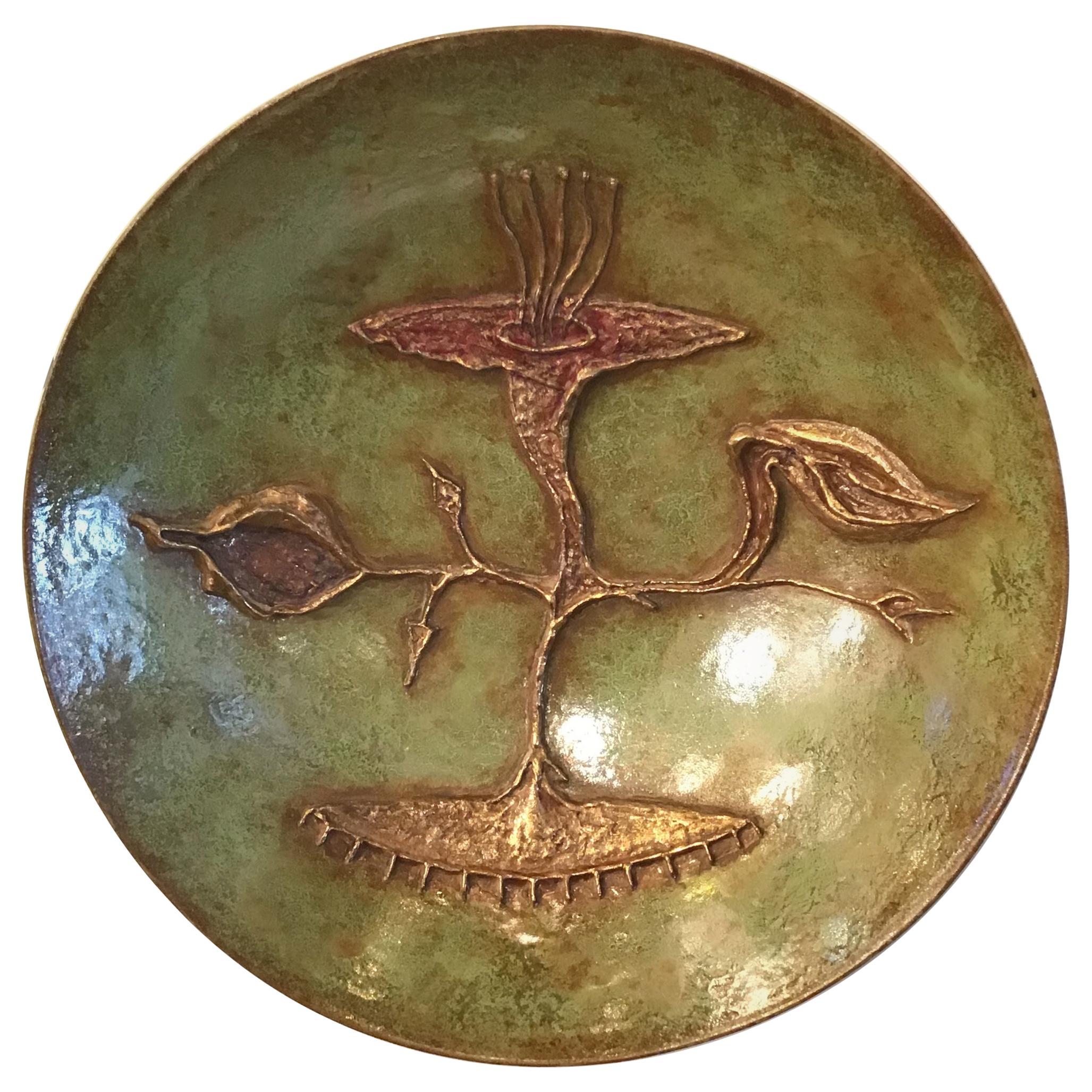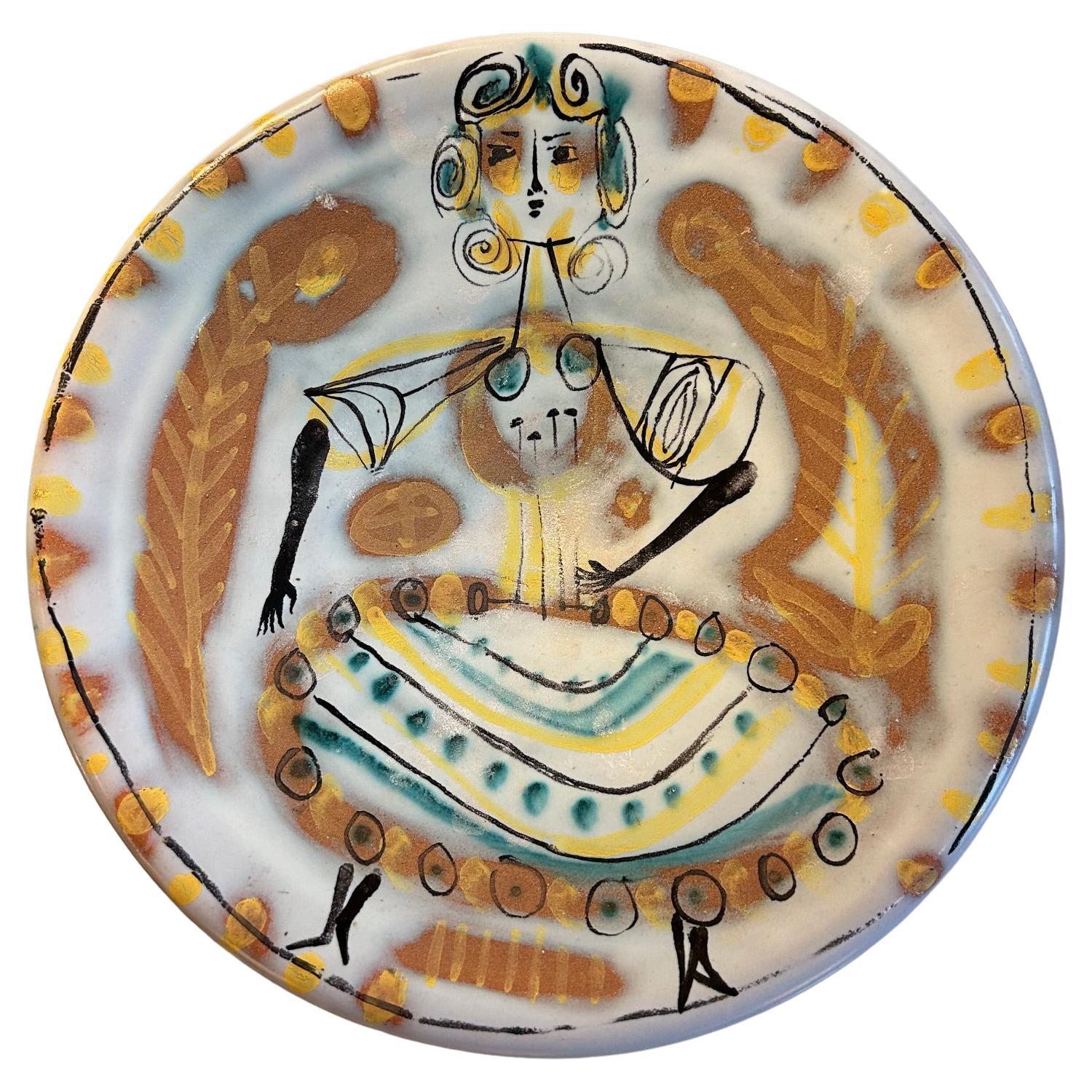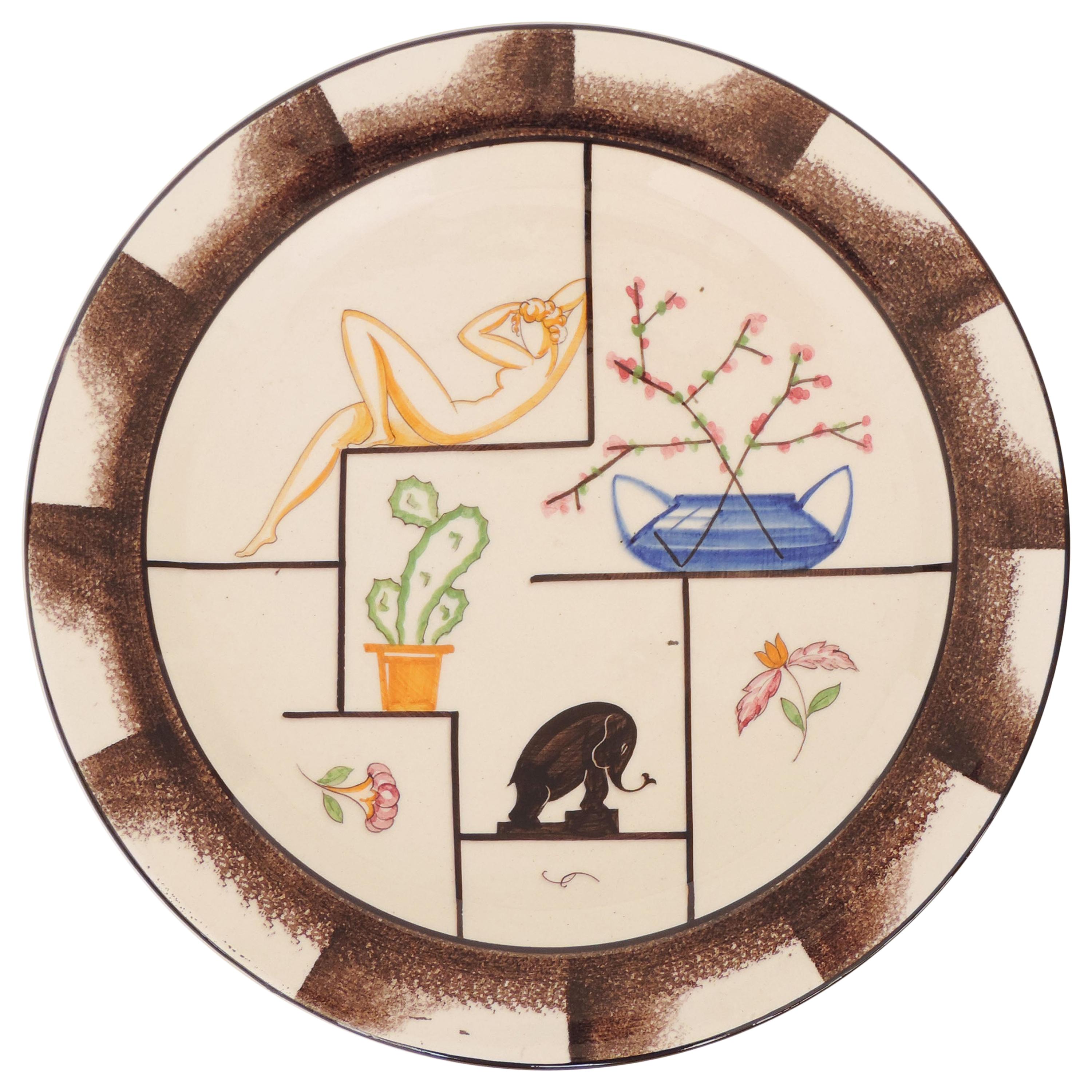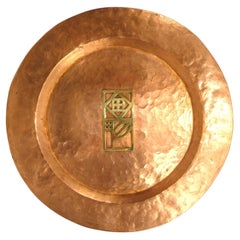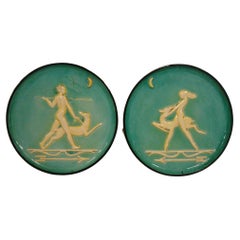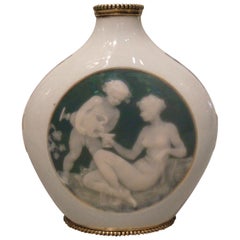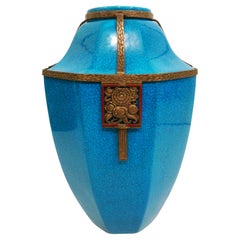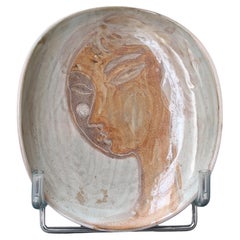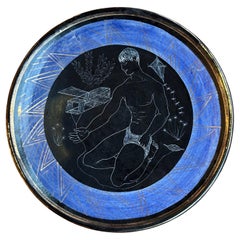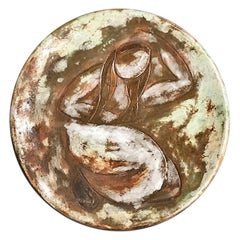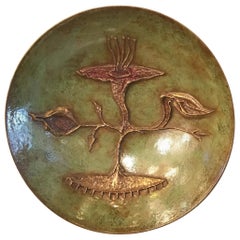Items Similar to Art Deco Andre Metthey Glazed Ceramic Plate / Charger. France 1910-20
Want more images or videos?
Request additional images or videos from the seller
1 of 15
Art Deco Andre Metthey Glazed Ceramic Plate / Charger. France 1910-20
$2,999
£2,275.57
€2,601.91
CA$4,188.79
A$4,657.36
CHF 2,431.82
MX$56,691.46
NOK 31,028.95
SEK 29,072.64
DKK 19,418.56
Shipping
Retrieving quote...The 1stDibs Promise:
Authenticity Guarantee,
Money-Back Guarantee,
24-Hour Cancellation
About the Item
Fantastic Art Deco Wall Glazed Ceramic Plate. A couple in Love. Very Romantic, both legs together form a heart. Spectacula piece of a fantastic Artist.
André Metthey – or Méthey name under which he signed his first works – is a ceramist born June 4, 1871 in Laignes in Côte-d'Or. André Metthey was the eldest of four children; very quickly, the family moved to Dijon. At the age of twelve, André Metthey began working for a marble worker and took industrial art classes at the École des beaux-arts in Dijon. André Metthey leaves Dijon with his family for Paris. Between November 1892 and September 1893, he did his military service in the 4th Infantry Regiment in Auxerre.
During a drawing competition, Metthey won Édouard Garnier's book on ceramics, which was at the origin of his vocation. At the end of the 1890s, he was an ornamental sculptor and worked for a time for the famous piano factory Pleyel, Lyon, Wolff & Cie. In 1901, André Metthey married Emma Louise Meunier with whom he had a son, Jean. It was that same year that he moved to Asnières-sur-Seine where he devoted himself fully to the art of ceramics and exhibited for the first time at the Salon des Indépendants.
At the Salon d'Automne in 1907, André Metthey presented works from his collaboration with painters such as Maurice Denis, Maurice de Vlaminck, Henri Matisse and Georges Rouault. Indeed, around 1906, under the impetus of the art dealer Ambroise Vollard, he had invited painters to his studio in Asnières to decorate his pieces in tanniferous earthenware. On this occasion, André Metthey took care to publish in the Grande Revue an article called "The Renaissance of Stanniferous Earthenware". This collaboration between Metthey and the painters soon ceased.
The year 1909 is that of consecration. He presented his glazed land to the general public and received great critical success. That same year, a solo exhibition was dedicated to him at the Musée Galliera in Paris.
In 1910, his workshop in Asnières was submerged by water due to the flooding of the Seine. Subsequently, Metthey was forced to cease its activity between 1914 and 1917 due to the First World War, and his workshop was within firing range of enemy lines.
He died on March 31, 1920 of tuberculosis, a disease that had plagued him all his life.
We have specialized in the sale of Art Deco and Art Nouveau and Vintage styles since 1995. If you have any questions we are at your disposal. Pushing the button that reads 'View All From Seller'. And you can see more objects to the style for sale. Why are there so many antiques in Argentina?
In the 1880 – 1940 there was a grate wave of immigration encouraged by the periods of war that were taking place. 1st World War took place between 1914 and 1918 2nd World War took place between 1939 and 1945 The immigrants options were New York or Buenos Aires. Tickets were cheap and in Buenos Aires they were welcomed with open arms, as it was a country where everything was still to be done. Argentina was the country of new opportunities, labour was needed and religious freedom was assured, in many cases the of the family travel first until they were settled and then the rest of the family members join them. In the immigrant museum “Ellis Island Immigrant Building” in New York you can se the promotional posters of the boats that would take them to a new life. Between the years 1895 and 1896, Argentina had the highest DGP (gross domestic product) per capita in the world according to the Maddison Historical Statistics index, this situation arose due to the large amount of food being exported to European countries, which were at war. The Argentinean ships left the port of Buenos Aires with food, but they returned with furniture, clothes and construction elements, (it´s common to see this the old buildings of the historic neighbourhood of San Telmo, the beams with the inscription “Made in England)”, as well as many markets that were built in Buenos Aires, such us the San Telmo Market, whose structure was brought by ship and afterwards assembled in 900 Defensa Street. With the great influence of European immigrants living in the country, the children of the upper classes travelled to study in France, resulting in the inauguration of “La Maison Argentinienne”, on 27th of June 1928, in the international city of Paris, which hosted many Argentinians that were studying in Frace. It´s the fourth house to be built after France, Canada and Belgium, being the first Spanish-speaking one. Still in place today (17 Bd Jourdan, 75014, Paris, France). Many of the children of these wealthy families who attended international art exhibitions, museums and art courses abroad, took a keen interest in the European style. This is why Buenos Aires was at the time referred as “The Paris of South America”. Between the years 1890 and 1920 more than a hundred Palaces were built on Alvear Avenue the most exclusive avenue in Buenos Aires. Today some of these palaces have been transformed into museums, hotels and embassies. In the year 1936, the Kavanagh building was inaugurated, it was the tallest reinforced concrete building in South America. During 1994 the American Society of Civil Engineers distinguished it as an “international engineering milestone”, and it´s now considered a World Heritage of Modern Architecture. At the time was common to hire foreign architects such as Le Corbusier, who visited Buenos Aires/Argentina in 1929 and in 1948 he drew up the blueprints for a house built in La Plata City (which was declared a World Heritage Site). In 1947, the Hungarian architect Marcelo Breuer designed “Parador Ariston” in the seaside city of Mar del Plata. After an Argentinean student at Harvard University convinced him to come to Argentina. He worked on an urban development project in the Casa Amarilla, area of La Boca. The Ukrainian architect, Vladimiro Acosta, arrives in Argentina in 1928 and worked as an architect until que moved to Brazil. Antonio Bonet, a Spanish architect who worked with Le Corbusier in Paris, arrives in Argentina in 1937, where he carried out several architectural works and in 1938 designs the well-known BFK chair. Andres Kálnay, of Hungarian origin, made around 120 architectural masterpieces, among which the former Munich brewery stands out, he even made the furniture’s design. The German architect, Walter Gropius, director of the Bauhaus, lived in Argentina, where he wrote articles for “Sur” magazine and founded in Buenos Aires, an architectural firm with Franz Möller, who was also an architect, where he built two houses. At the same time several famous designers decided to immigrate to Argentina, among them we can find the well-known French designer, Jean-Michel Frank, who arrived in the country in 1940 and also worked for the Rockefeller family. Special pieces were made, which were sold exclusively in the country, such as the well-known German company “WMF”, who sold their products by catalogue, which were chosen by the ladies of high society in the list of wedding gifts, as well as the pieces designed by Christofle. The Swiss sculptor Alberto Giacometti, made special pieces for Argentinean mansions. In 1904 the first Jansen branch outside Paris was established in Buenos Aires, as the Argentinean clientele demanded a large amount of furniture, from the end of the 19th century to the mid-20th century. In 1970, the brand Rigolleau Argentina made pieces authorised by Lalique. The brands Maple and Thompson also set up shop in the country. The French plastic artist, Marcel Duchamp moved to Argentina in 1918-1919. Glass signed Gallé, Charder, Leverre, Schneider, Muller and other French firms. They were bought in flower shops and were given to ladies with beautiful floral arrangements. Some furniture manufacturers travelled to international fairs and bough the patterns to produce the furniture in Argentina, such as the furniture firm Englander and Bonta, who bought the patterns in Italy. It is worth mentioning that in Argentina we have the largest community of Italians outside of Italy, as it is estimated that 70 percent of the inhabitants have at least one Italian descendant, followed by Spanish immigrants. The most Important furniture stores in Argentina: Comte is founded in 1934 (under the direct management of Jean Michel Frank in 1940). Nordiska (Swedish company established in 1934). Churba in 1960, a company that brought foreign designers to present their furniture in the country: Denmark: (Arne Jacobsen, Finn Juhl, Bender Madsen, Ejner Larsen, Poul Kjaerholm, Hans Wegner) Sweden: (Hans Agne Jakobsson, Gustavsberg) United States: (Herman Miller) Finland: (Lisa Johansson, Folke Arstrom, Tapio Wirkkala, Alvar Aalto, Timo Sarpaneva) Swedish Factory: (Orrefors) Italy: (Littala, Vico Magistretti, Emma Gismondi, Gae Aulenti, Angelo Mangiarotti, Elio Martinelli, Gianna Celada, Angelo Mangiarotti, Mario Bellini, Carlo Scarpa) Finland: (Olivia Toikka) Plata Lappas (Lappas Silver): a goldsmith shop founded in 1887 in Argentina by Alcibiades Lappas of Greek origin. In 2019, in Argentina took place “the Art Deco world congress” . Argentina currently has more than 100 Art Deco buildings and another 90 Art Nouveau buildings throughout the city of Buenos Aires. Argentina is a country that has not been involved in many wars, which is why it has been a refuge for works of art and antiques from different periods of time, unlike European countries. That is way many collectors, museums and antique dealers from all over the world visit it, you should not miss the opportunity to visit this great country.
- Creator:André Metthey (Artist)
- Dimensions:Height: 11.23 in (28.5 cm)Diameter: 1.58 in (4 cm)
- Style:Art Deco (In the Style Of)
- Materials and Techniques:Ceramic,Glazed
- Place of Origin:
- Period:
- Date of Manufacture:1910-20
- Condition:Wear consistent with age and use. Excellent conditions.
- Seller Location:Buenos Aires, AR
- Reference Number:1stDibs: LU2027331037802
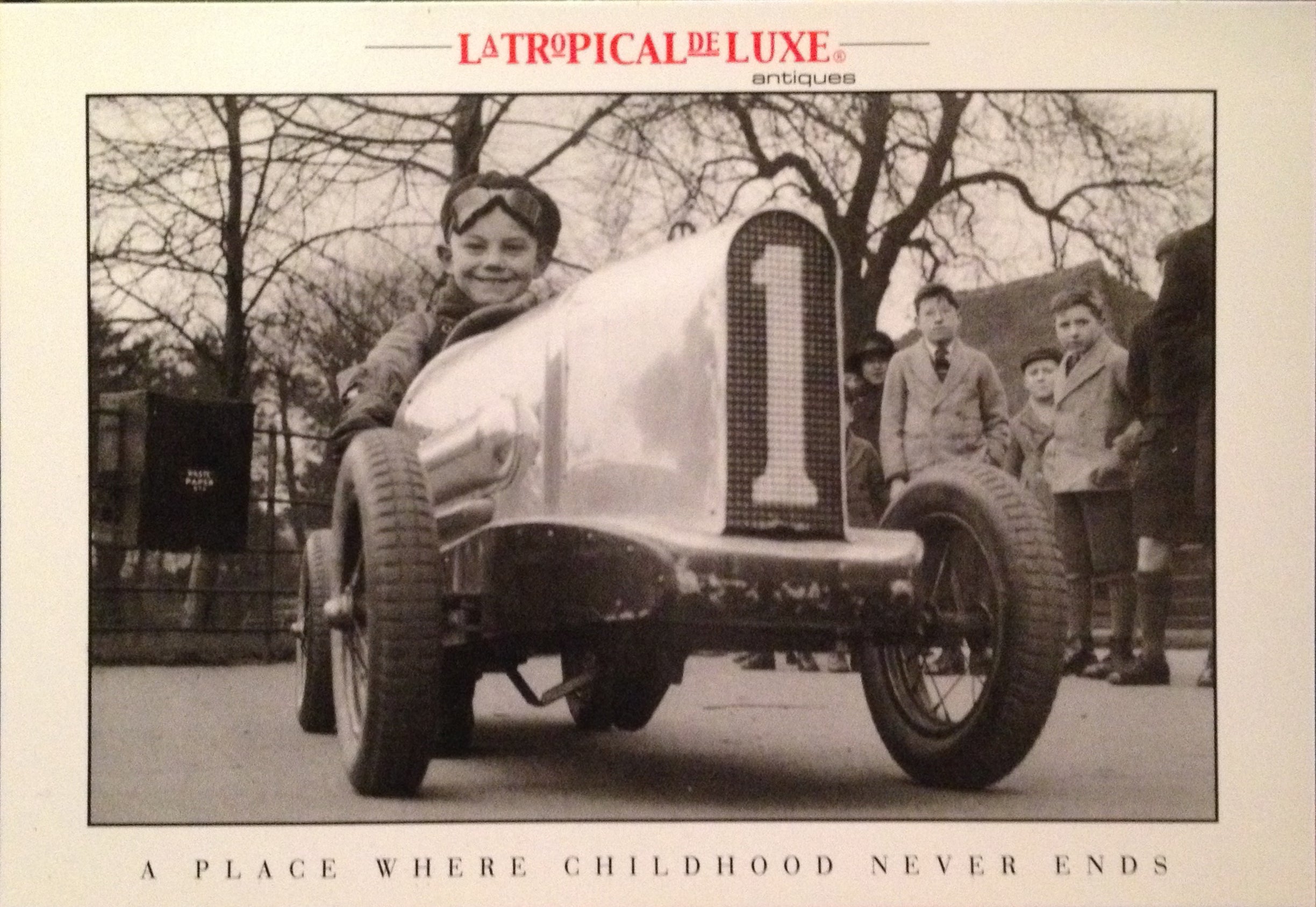
About the Seller
4.9
Vetted Professional Seller
Every seller passes strict standards for authenticity and reliability
Established in 2002
1stDibs seller since 2016
320 sales on 1stDibs
Typical response time: 1 hour
- ShippingRetrieving quote...Shipping from: Buenos Aires, Argentina
- Return Policy
Authenticity Guarantee
In the unlikely event there’s an issue with an item’s authenticity, contact us within 1 year for a full refund. DetailsMoney-Back Guarantee
If your item is not as described, is damaged in transit, or does not arrive, contact us within 7 days for a full refund. Details24-Hour Cancellation
You have a 24-hour grace period in which to reconsider your purchase, with no questions asked.Vetted Professional Sellers
Our world-class sellers must adhere to strict standards for service and quality, maintaining the integrity of our listings.Price-Match Guarantee
If you find that a seller listed the same item for a lower price elsewhere, we’ll match it.Trusted Global Delivery
Our best-in-class carrier network provides specialized shipping options worldwide, including custom delivery.More From This Seller
View AllJosef Hoffmann - Wiener Werkstatte - Art Deco Copper Hand Hammered Plates
By Josef Hoffmann
Located in Buenos Aires, Olivos
Josef Hoffmann - Wiener Werkstatte - Art Deco Copper Hand Hammered Plates. We have 5 plates that will be sold individualy.
WIENER WERKSTATTE
The Wiener Werkstatte (Vienna Workshop) exerted an enormous influence on artists and designers throughout the first part of the 20th century. In 1897 a group of progressive artists and designers, led by architect Josef Hoffman and painter Koloman Moser, formed the Vienna Secession which became the Wiener Werkstätte Produktiv-Gemeinschaft von Kunsthandwerken, Wien (the Viennese Workshop and Production Cooperative of Art Works in Vienna) in 1903 when they received backing from a prominent businessman. This enabled them to equip workshops especially for working on modern design in a range of applied arts like glass, metalwork and jewellery.Online art courses
The aim of the Wiener Werkstatte artists and designers was to bring good design and art into every part of people's lives. They also wanted to break with the past and bring new style to everything they produced. Emphasis was placed on the beautiful and unique as well as faultless craftsmanship.
The concept was modeled after Charles Robert Ashbee's Guild of Handicraft. By 1905 it had over a hundred craftsmen, of whom 37 were masters of their trade, its strong point being handmade metalware whose reductive style proved its dependence on hand production.
In addition to the workshops on its own premises, the Wiener Werkstätte had recourse to free-lance craftsmen, students at Kunstgewerbeschule of Vienna (the School of Applied Arts, where both Hoffmann and Moser taught) and contemporary industry. Furniture production, for example, though at one point part of the Werkstätte's program, was more congenially licensed to outside manufacturers such as Gebrüder Thonet and J. & J. Kohn. In 1907, the Wiener Werkstätte took over distribution for the Wiener Keramik, a ceramics workshop of kindred spirit headed by Michael Powolny and Berthold Löffler...
Category
Early 20th Century Austrian Vienna Secession Tableware
Materials
Brass, Copper
Vintage Tarcisio Tosin, La Freccia Wall Plated, Glazed Ceramic, Italy, 1934
By Tarcisio Tosin
Located in Buenos Aires, Olivos
Vintage Tarcisio Tosin - La Freccia wall plated - Glazed Ceramic, Italy 1934
hand painted under glaze from the 1934 to the 1942.
The Diana Huntress St...
Category
Mid-20th Century Italian Mid-Century Modern Decorative Art
Materials
Ceramic
Art Nouveau Flower Vase Limoges Porcelain and Silver by Joe Descomps
By Limoges, Joe Descomps Cormier
Located in Buenos Aires, Olivos
Flower vase
On one side it has a nude - Erotic lady drinking wine, and on the other a devil. Very nice quality enamel porcelain flower vase. It has silver rings on the neck and on t...
Category
20th Century French Art Nouveau Porcelain
Materials
Porcelain
$750 Sale Price
21% Off
Art Deco Boch La Louviere Brass Mounted Glazed Vase. Belgium 1920´s
By Boch La Louviere
Located in Buenos Aires, Olivos
Art Deco Boch La Louviere Brass Mounted Glazed Vase. Belgium 1920´s.
Very Rare blue Glazed ceramic vase. The vase has a hexagonal shape and is adorned with bronze or brass decorati...
Category
Vintage 1920s Belgian Art Deco Vases
Materials
Brass
$2,800 Sale Price
20% Off
Art Deco Painted Wood Mirror by Albert Binquet, ca 1921
By Albert Binquet
Located in Buenos Aires, Olivos
Albert Binquet
Hand mirror, circa 1921
Made of wood, painted in ivory color, representing a stylized mask, the eyebrows and outer edges of the eyes underlined with black paint
Measures: Height: 24 cm. (91/2 in.) ; Width: 14 cm. (51/2 in.)
Signed in reverse A.BINQUET
Size of the mirror without the stand: 24 cm high, by 14.2 cm wide, by 1.5 cm depth.
A PAINTED WOOD MIRROR BY ALBERT BINQUET, CIRCA 1921
Subsequent to completion of his training in Barcelona, Albert Binquet, a native of Bordeaux, who trained at the Fine Art School, returned to France and collaborated with Émile-Jacques Ruhlmann to create certain sculptural reliefs for furniture, and for Robert Mallet-Stevens, a neo-Antique mask...
Category
Early 20th Century French Art Deco Table Mirrors
Materials
Wood
Alexandre Noll Exotic Wood Cigar Ashtray Bowl / Dish Signed, France, circa 1950
By Alexandre Noll
Located in Buenos Aires, Olivos
Lovely Alexandre Noll cigar ashtray / bowl / Dish. Carved in exotic wood.
Alexandre Noll hand carved Cigar Ashtray.
Mid-century.
France, c. 1950
Hand carved signature to underside '...
Category
Vintage 1940s French Mid-Century Modern More Furniture and Collectibles
Materials
Wood
$4,400 Sale Price
20% Off
Free Shipping
You May Also Like
French Mid-Century Decorative Ceramic Plate by Atelier du Grand Chêne
By Le Grand Chêne 1
Located in London, GB
French Mid-Century curved ceramic plate hand-painted with a woman's face with short hair, by Atelier du Grand Chêne (circa 1950s). The piece is absolutely charming and has a whiff of Picasso about it - indeed the couple who founded Le Grand Chêne...
Category
Vintage 1950s French Decorative Dishes and Vide-Poche
Materials
Ceramic
$603 Sale Price
20% Off
Ceramic plate by Accolay, signed France, 1960s
By Accolay Pottery
Located in Paris, FR
Accolay ceramic plate, France, 1960s.
Category
Vintage 1960s French Ceramics
Materials
Ceramic
$5,756 / set
Alexandre Kostanda in Vallauris, Dish with Incised Decoration
By Alexandre Kostanda
Located in Saint-Ouen, FR
Alexandre Kostanda (1921-2007) in Vallauris.
Dish with incised decoration of a woman on a light brown background.
signed under the base.
Category
Vintage 1950s French Mid-Century Modern Decorative Dishes and Vide-Poche
Materials
Ceramic
Pietro Melandri Centerpiece or Decorative Wall Plate Ceramic, 1950, Italy
By Pietro Melandri
Located in Milano, IT
Pietro Melandri centerpiece or decorative wall plate ceramic, 1950, Italy.
Category
Vintage 1950s Italian Other Centerpieces
Materials
Ceramic
Ceramic plate by Roger Capron, France, 1960's
By Roger Capron
Located in Paris, FR
Ceramic plate by Roger Capron, signed, 1960's
Category
Vintage 1960s French Modern Ceramics
Materials
Ceramic
Carraresi e Lucchesi, Sesto Fiorentino Italian Art Deco Decorative Plate, 1930s
Located in Milan, IT
Large Carraresi e Lucchesi, Sesto Fiorentino Italian Art Deco decorative plate, 1930s.
Category
Vintage 1930s Italian Art Deco Ceramics
Materials
Ceramic
$2,878 Sale Price
20% Off
More Ways To Browse
Italian Art Deco Ceramics
Greek Pattern Plates
Community Silver Plate
Art Glass Charger
Mid Century Swedish Ceramics Plates
French Charger
French Grande Poster
Carlo Scarpa Book
Marcel Breuer Book
Alvar Aalto Book
Michel Henri
Marble Charger
Lyon Industrial
Frank And Sons Chair
Jean Michel Frank Book
Johansson Soner
Vintage Silver Charger
Maurice Ceramic
